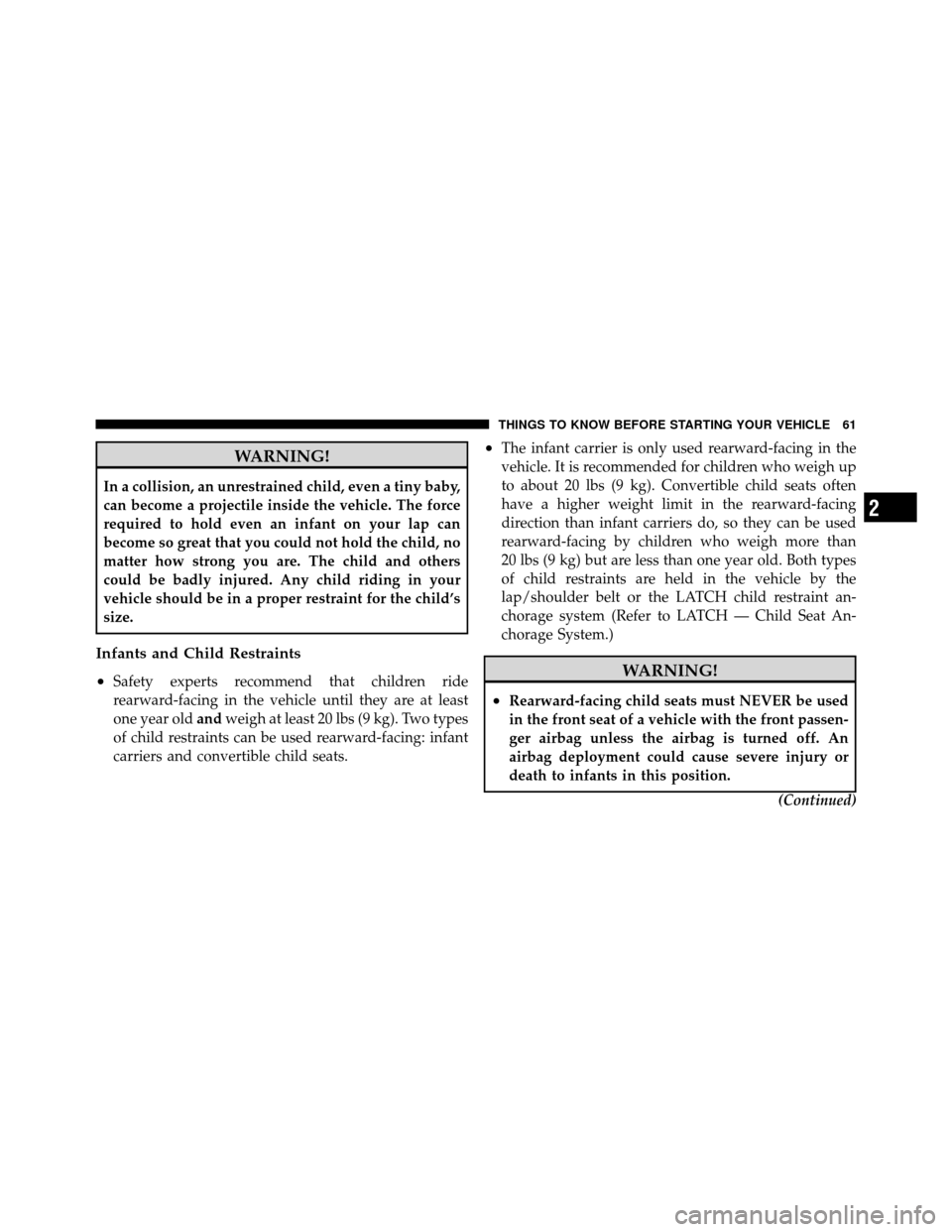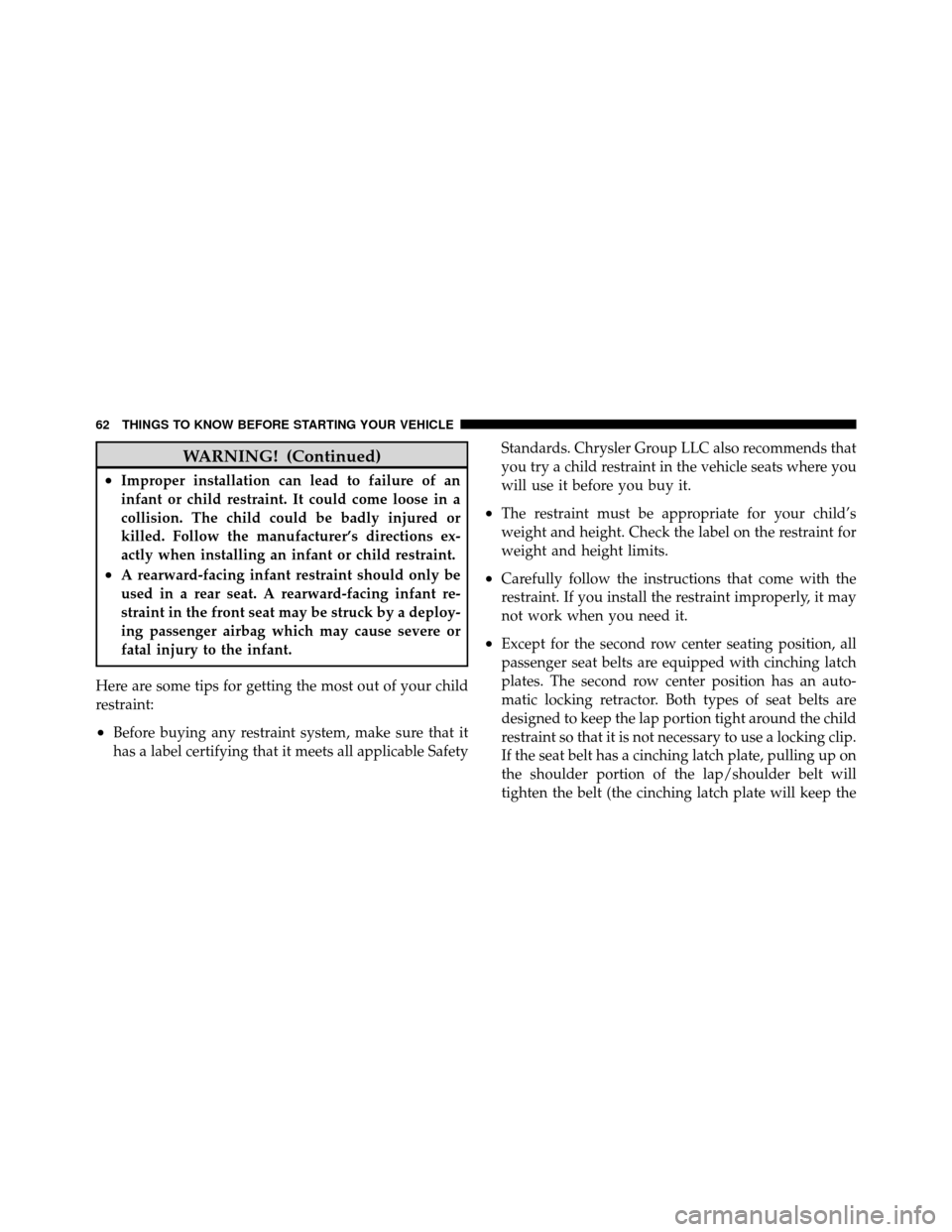Page 62 of 407

WARNING!
In a collision, an unrestrained child, even a tiny baby,
can become a projectile inside the vehicle. The force
required to hold even an infant on your lap can
become so great that you could not hold the child, no
matter how strong you are. The child and others
could be badly injured. Any child riding in your
vehicle should be in a proper restraint for the child’s
size.
Infants and Child Restraints
•
Safety experts recommend that children ride
rearward-facing in the vehicle until they are at least
one year oldandweigh at least 20 lbs (9 kg). Two types
of child restraints can be used rearward-facing: infant
carriers and convertible child seats.
•The infant carrier is only used rearward-facing in the
vehicle. It is recommended for children who weigh up
to about 20 lbs (9 kg). Convertible child seats often
have a higher weight limit in the rearward-facing
direction than infant carriers do, so they can be used
rearward-facing by children who weigh more than
20 lbs (9 kg) but are less than one year old. Both types
of child restraints are held in the vehicle by the
lap/shoulder belt or the LATCH child restraint an-
chorage system (Refer to LATCH — Child Seat An-
chorage System.)
WARNING!
•Rearward-facing child seats must NEVER be used
in the front seat of a vehicle with the front passen-
ger airbag unless the airbag is turned off. An
airbag deployment could cause severe injury or
death to infants in this position.
(Continued)
2
THINGS TO KNOW BEFORE STARTING YOUR VEHICLE 61
Page 63 of 407

WARNING! (Continued)
•Improper installation can lead to failure of an
infant or child restraint. It could come loose in a
collision. The child could be badly injured or
killed. Follow the manufacturer’s directions ex-
actly when installing an infant or child restraint.
•A rearward-facing infant restraint should only be
used in a rear seat. A rearward-facing infant re-
straint in the front seat may be struck by a deploy-
ing passenger airbag which may cause severe or
fatal injury to the infant.
Here are some tips for getting the most out of your child
restraint:
•Before buying any restraint system, make sure that it
has a label certifying that it meets all applicable Safety Standards. Chrysler Group LLC also recommends that
you try a child restraint in the vehicle seats where you
will use it before you buy it.
•The restraint must be appropriate for your child’s
weight and height. Check the label on the restraint for
weight and height limits.
•Carefully follow the instructions that come with the
restraint. If you install the restraint improperly, it may
not work when you need it.
•Except for the second row center seating position, all
passenger seat belts are equipped with cinching latch
plates. The second row center position has an auto-
matic locking retractor. Both types of seat belts are
designed to keep the lap portion tight around the child
restraint so that it is not necessary to use a locking clip.
If the seat belt has a cinching latch plate, pulling up on
the shoulder portion of the lap/shoulder belt will
tighten the belt (the cinching latch plate will keep the
62 THINGS TO KNOW BEFORE STARTING YOUR VEHICLE
Page 147 of 407
Cargo Tie-Down Hooks
The cargo tie-downs, located on the cargo area floor,
should be used to safely secure loads when the vehicle is
moving.WARNING!
•To help protect against personal injury, passengers
should not be seated in the rear cargo area. The
rear cargo space is intended for load carrying
purposes only, not for passengers, who should sit
in seats and use seat belts.
•Cargo tie-down hooks are not safe anchors for a
child seat tether strap. In a sudden stop or colli-
sion, a hook could pull loose and allow the child
seat to come loose. A child could be badly injured.
Use only the anchors provided for child seat
tethers.
The weight and position of cargo and passengers
can change the vehicle center of gravity and ve-
hicle handling. To avoid loss of control resulting
in personal injury, follow these guidelines for
loading your vehicle:(Continued)
Cargo Tie-Down Hooks
146 UNDERSTANDING THE FEATURES OF YOUR VEHICLE
Page 148 of 407
WARNING! (Continued)
•Do not carry loads which exceed the load limits
described on the label attached to the left door or
left door center pillar.
•Always place cargo evenly on the cargo floor. Put
heavier objects as low and as far forward as
possible.
•Place as much cargo as possible in front of the rear
axle. Too much weight or improperly placed
weight over or behind the rear axle can cause the
rear of the vehicle to sway.
•Do not pile luggage or cargo higher than the top of
the seatback. This could impair visibility or be-
come a dangerous projectile in a sudden stop or
collision.
Cargo Load Floor
The panel in the load floor is reversible for added utility.
One side is carpeted and the other side features a plastic
lined tray which holds a variety of items.
Cargo Load Floor
3
UNDERSTANDING THE FEATURES OF YOUR VEHICLE 147
Page 172 of 407
•1/4 Mile (if equipped with Performance Pages)
•Instantaneous G-Force (if equipped with Performance
Pages)
•Peak G-Force (if equipped with Performance Pages)
•RKE BATTERY LOW
•VEHICLE NOT IN PARK
•IGNITION POSITION
•PRESS BRAKE TO START
•INSERT KEY
•TURN TO ON
Trip Functions
Press and release the MENU button until one of the
following Trip Functions displays in the EVIC:
•Distance To Empty
•Trip A
•Trip B
•Elapsed Time
•Service Distance
•Engine Oil Pressure
•Engine Oil Temperature
•Display Units of Measure In
Press the SCROLL button to cycle through all the Trip
Computer functions.
The Trip Functions mode displays the following informa-
tion:
•Distance To Empty (DTE)
Shows the estimated distance that can be traveled with
the fuel remaining in the tank. This estimated distance is
determined by a weighted average of the instantaneous
4
UNDERSTANDING YOUR INSTRUMENT PANEL 171
Page 238 of 407

▫Replacement Tires .................... 277
� Tire Rotation Recommendations ........... 278
� Tire Pressure Monitor System (TPMS) ....... 279
▫ Premium System .................... 279
▫ General Information .................. 282
� Fuel Requirements ..................... 282
▫ 6.1L Engine ........................ 282
▫ Reformulated Gasoline ................ 283
▫ Gasoline/Oxygenate Blends ............. 283
▫ E85 Usage In Non-Flex Fuel Vehicles ...... 284
▫ MMT In Gasoline .................... 284
▫ Materials Added To Fuel ............... 285
▫ Fuel System Cautions ................. 285 ▫
Carbon Monoxide Warnings ............ 286
� Adding Fuel ......................... 287
▫ Fuel Filler Cap (Gas Cap) .............. 287
▫ Loose Fuel Filler Cap Message ........... 288
� Trailer Towing ........................ 289
▫ Common Towing Definitions ............ 289
▫ Trailer Hitch Classification .............. 292
▫ Trailer Towing Weights
(Maximum Trailer Weight Ratings) ........ 293
▫ Trailer And Trailer Tongue Weight ........ 293
▫ Towing Requirements ................. 295
▫ Towing Tips ........................ 298
� Recreational Towing
(Behind Motorhome, Etc.) ................ 299
5
STARTING AND OPERATING 237
Page 261 of 407

Off” mode by pressing the “ESP OFF” switch. Once the
situation requiring ESP to be switched to the “ESP Partial
Off” mode is overcome, turn ESP back on by momen-
tarily pressing the “ESP OFF” switch. This may be done
while the vehicle is in motion.
Trailer Sway Control (TSC)
TSC uses sensors in the vehicle to recognize an exces-
sively swaying trailer and will take the appropriate
actions to attempt to stop the sway. The system may
reduce engine power and apply the brake of the appro-
priate wheel(s) to counteract the sway of the trailer. TSC
will become active automatically once an excessively
swaying trailer is recognized. No driver action is re-
quired. Note that TSC cannot stop all trailers from
swaying. Always use caution when towing a trailer and
follow the tongue weight recommendations. Refer to
“Trailer Towing” in “Starting and Operating” for further
information. When TSC is functioning, the “ESP/TCS
Indicator Light” will flash, the engine power may bereduced and you may feel the brakes being applied to
individual wheels to attempt to stop the trailer from
swaying. TSC is disabled when the ESP system is in the
“Partial Off” mode.
WARNING!
If TSC activates while driving, slow the vehicle
down, stop at the nearest safe location, and adjust the
trailer load to eliminate trailer sway.
ESP/BAS Warning Light and ESP/TCS Indicator
Light
The malfunction indicator lamp for the ESP is
combined with the BAS indicator. The “ESP/
BAS Warning Light” and the “ESP/TCS Indi-
cator Light” in the instrument cluster both
come on when the ignition switch is turned to the ON
position. They should both go out with the engine
running.
260 STARTING AND OPERATING
Page 269 of 407
Tire Loading and Tire Pressure
Tire Placard Location
NOTE:The proper cold tire inflation pressure is listed
on the driver’s side B-Pillar.
Tire and Loading Information Placard
This placard tells you important information about
the:
1) number of people that can be carried in the vehicle
2) total weight your vehicle can carry
Tire Placard Location
Tire and Loading Information Placard
268 STARTING AND OPERATING